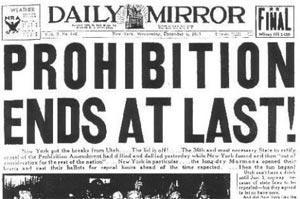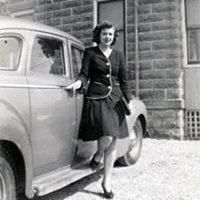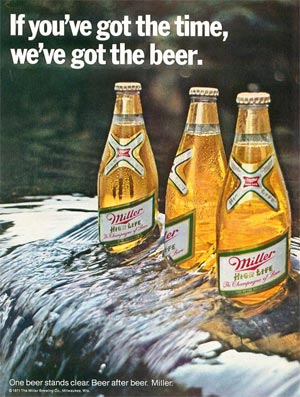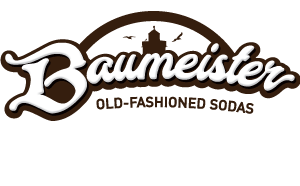Triangle Distributing
Triangle Distributing...a history rich in family and beer tradition.
1932...
George Ziegelbauer, Sr. was an established butcher, operating a meat market & grocery store in Two Rivers, Wisconsin. During these grocery store days he had established a strong relationship with Pabst.
During prohibition he made it a practice of purchasing hops, yeast and malts from these breweries. His customers would purchase these supplies from him to make their illegal home brews.
December 5th, 1933...

After the repeal of prohibition the breweries found themselves in a unique position; they could brew and package beer, but they could not distribute it to retailers. A scramble ensued to set up beer distributors and for the current "three-tier" system of delivery.
“Red Cap" Gettlemen & Schlitz became the first breweries George Ziegelbauer Sr. began to distribute. Other Milwaukee breweries soon followed. These opportunities changed George from a grocery store owner to a beer distributor literally over night.
In 1936, the Schlitz salesmen suggested that it might be better to be located in the largest city in the county. So George Sr. rented a building at the northeast corner of South 18th and Franklin Street in Manitowoc, WI.
In 1937, George Sr. had the opportunity to acquire from the Chicago and Northwestern Rail Road Co. a former stockyard piece of land between South 18th Street and South 19th Street on the North side of Franklin Street and North of a Rail Road siding track. He then erected a Butler steel building facing 19th Street.
In 1940, George Sr. had the chance to purchase some refrigerated boxcars from Anheuser Busch. The first one received was full of Budweiser. After removing the beer and wheels, which were sold back to the Rail Road, it was placed behind the steel building and used as a cooler for the keg beer. After two more boxcars were received and placed parallel to the first one, the warehouse was then complete.
1943...
There was some shortage of beer during World War II because the Federal Government had put restrictions on the use of certain supplies.

After World War II ended in 1945, the servicemen started coming home. This included George Sr.’s two sons, George Jr. and James. Prohibition has been repealed and the economy was picking up.
As the beer business grew, George Sr. established three locations for his warehouses. These operating facilities were in Fond du Lac, Green Bay and Manitowoc, Wisconsin. By the time George Ziegelbauer, Jr. entered the business in 1948, George Sr. had separated the businesses. George Sr. gave two of the three brothers a branch. Jim was given Manitowoc, George Jr. was given Green Bay and Fond du Lac was sold. At the time of the split the boys were Budweiser distributors.
Breweries were demanding the distributors be more exclusive with their products. When Budweiser pressed the boys to be exclusive they ended their relationship.
Breweries and distributors were involved in intense deal-making. Beer distributorships and beer brands were very plentiful. Relationships lacked loyalty. Breweries were only concerned with controlling brands and volume from their partner distributors. Beer was sold on relationships, personality and charisma…and George was blessed with all those characteristics. It wasn't the brands tap knob; it was George's tap knob!

The work was hard and the days were long. Triangle's personnel consisted of the owner, the bookkeeper and the drivers. They would begin their day at 5:00 A.M unloading the train carloads that had been delivered. If they got done early, the drivers would deliver the beer.
After the work was done, the selling began. It was all social! George Jr. picked up tap knobs at night. Some nights until 8 or 9 P.M. Success as a distributor was dependent on belonging to social clubs that built successful relationships.

Unfortunately, in 1965 George was involved in a serious car accident, which left him in need of constant care. Leona, his wife took over the business. With seven children at home she did not have the luxury of working the market the way George and she had done. Her family obligations and her gender presented its own struggles.

By the time George Jr and Leona's son, Gary Ziegelbauer, had come into the industry there was great change occurring and the age of media was coming into its own. Beer selling had moved away from relationship-building being the sole means of selling the product. Relationship selling is still an important part of the beer business and it works in conjunction with marketing. Moving the local marketing to the national level was a huge step in brand recognition.
1970 - Tobacco giant, Phillip Morris acquired full ownership of Miller Brewing
Beer had been advertising for a long time, but the impact of the age of media really began to hit. When Phillip Morris purchased Miller Brewing, the company had big plans for Miller, hoping to apply some of the same advertising strategies to the beer industry that had been applied to propel Marlboro cigarettes to the top position within the tobacco industry.
When beer distributors from around the country converged on Boca Raton, FL for Miller Brewing's national sales meeting in January of 1971, they unveiled their advertising strategy. The focal point of the gathering was Miller's launch of a nationwide advertising campaign centered on the slogan:

A new genre of beer commercial was about to be born, and television was the focus. The focus wasn't just about the flavor of the beer, but that you worked hard all day and now it was Miller Time.
By 1983,
92% of beer was sold by the top 6 brewers
Big brewers began to dominate the industry. Regional breweries began to falter. The switch from returnable bottle to throw-away bottles made the local brewers no longer the economical choice for the consumer. Near the end of the 1970s there were only 44 breweries in the United States. In comparison, there had been 2,000 independent brewing companies making beer in America.
Craft brewers expolded in the 1990's. Where it was once the ecomonical choice for beer drinkers they reinvented themselves. They have positioned themselves as craft brewers with the premium product. They have created the call for consumers to demand a more unique experience with their beer. Beer drinkers are starting to drink less, but better beer. Pairing beer and food is becoming a growing trend as consumers are becoming more knowledgeable about beer styles.
Today's consumer demands variety and innovation in all it's beverage products. The beverage industry continues to have it's segments divided up into products such as seltzers, sparkling drinks, innovative flavors, ciders, teas etc. The list grows and changes and todays wholesaler must continue to partner with beverage companies that bring that excitement and product development to the consumer.


